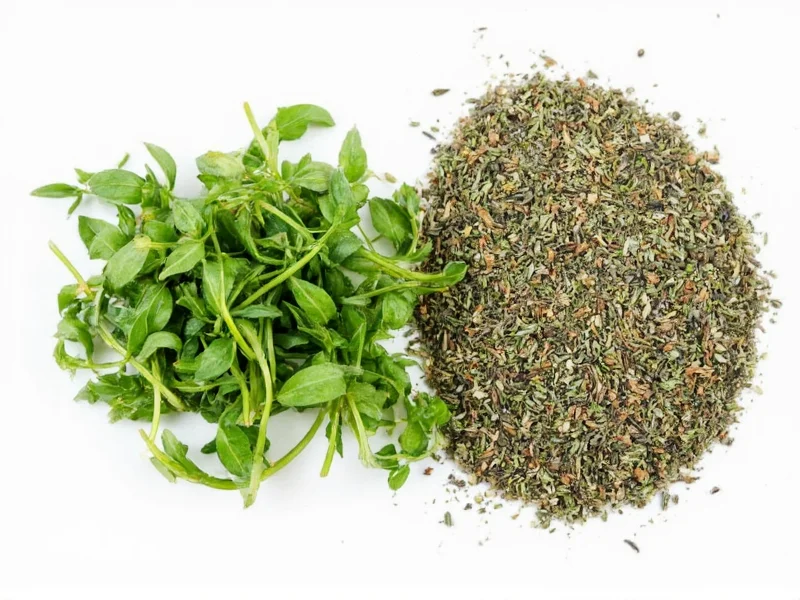Understanding herb conversions is essential for achieving perfect flavor balance in your cooking. When substituting dried thyme for fresh (or vice versa), getting the measurements right makes the difference between a beautifully seasoned dish and one that's overpowering or bland.
Why the 3:1 Fresh to Dried Thyme Ratio Works
Thyme loses about 70-80% of its moisture content when dried, concentrating its essential oils and flavor compounds. This scientific principle behind herb drying explains why you need less dried thyme to achieve equivalent flavor. The 3:1 ratio (3 parts fresh to 1 part dried) has been validated through culinary testing across countless recipes and cooking applications.
Proper Measurement Techniques for Accurate Substitutions
How you measure makes a significant difference in your results. For fresh thyme:
- Strip leaves from stems before measuring
- Gently pack leaves into measuring spoon
- Don't compress - light packing only
For dried thyme:
- Use a proper measuring teaspoon
- Level off with straight edge
- Avoid packing unless recipe specifically states to do so
| Recipe Calls For | Substitute With | Flavor Adjustment Tip |
|---|---|---|
| 1 tablespoon fresh thyme | 1 teaspoon dried thyme | Standard conversion for most recipes |
| 2 tablespoons fresh thyme | 2 teaspoons dried thyme | Consider reducing by 1/4 teaspoon if using older dried thyme |
| 1/4 cup fresh thyme | 1 tablespoon dried thyme | Add dried thyme early in cooking for maximum flavor extraction |
| 1 teaspoon dried thyme | 1 tablespoon fresh thyme | Add fresh thyme near end of cooking to preserve delicate flavor |
When to Adjust the Standard Conversion Ratio
While the 3:1 ratio works for most applications, certain factors may require slight adjustments:
Recipe Type Considerations
Long-simmering dishes like stews and braises benefit from using 25% less dried thyme than the standard conversion suggests. The extended cooking time allows for more flavor extraction from dried herbs. For quick-cooking dishes like sautés or finishing sauces, you might need to increase dried thyme by 10-15% since there's less time for flavor development.
Dried Thyme Age Matters
Dried thyme loses potency over time. Properly stored in an airtight container away from light and heat, dried thyme maintains peak flavor for 6-12 months. After one year, you may need to increase the amount by 25-50% to achieve equivalent flavor to fresh. Always check your dried thyme's aroma - if it has little scent, it's lost most of its flavor compounds.
Common Substitution Mistakes to Avoid
Many home cooks make these critical errors when converting fresh thyme to dried:
- Measuring with stems included - Fresh thyme stems are woody and inedible. Always remove leaves from stems before measuring
- Overpacking dried thyme - Unlike spices like cinnamon, dried thyme shouldn't be tightly packed
- Adding dried thyme too late - Dried herbs need time to rehydrate and release flavors, so add them earlier than fresh
- Using the same timing - Fresh thyme added at the end preserves delicate flavors, while dried needs cooking time
Practical Recipe Application
Consider a classic French bouquet garni that traditionally uses fresh thyme. If substituting dried thyme for fresh in a coq au vin recipe:
- Original recipe: 3 sprigs fresh thyme (about 1 tablespoon leaves)
- Correct substitution: 1 teaspoon dried thyme
- Method: Add dried thyme with other dried herbs at the beginning of cooking, not tied in a bundle like fresh
For a fresh tomato basil pasta that calls for 2 tablespoons fresh thyme:
- Substitute with 2 teaspoons dried thyme
- Add during the last 5-7 minutes of cooking rather than at the end
- Consider reducing by 1/4 teaspoon if your dried thyme is older than 6 months
Storage Tips for Maximum Flavor Preservation
Proper storage affects your conversion accuracy. Fresh thyme lasts 10-14 days when stored properly:
- Wrap in slightly damp paper towel
- Place in airtight container
- Store in refrigerator crisper drawer
Dried thyme maintains best quality for 6-12 months when:
- Stored in opaque, airtight container
- Kept away from heat sources and direct light
- Not exposed to humidity or temperature fluctuations
When Fresh and Dried Aren't Interchangeable
Some dishes truly require one form over the other. Delicate preparations like fresh herb salads, certain seafood dishes, or finishing garnishes benefit from the bright, grassy notes of fresh thyme that dried simply cannot replicate. Conversely, long-cooked dishes like beef bourguignon or hearty bean soups often work better with dried thyme's more concentrated, earthy flavor profile that withstands extended cooking.
Expert Tips for Perfect Thyme Substitutions
Professional chefs recommend these advanced techniques:
- Rehydrate dried thyme - Mix with 1-2 teaspoons of warm water or broth before adding to dishes for faster flavor release
- Toast dried thyme - Briefly heat in dry pan before use to enhance flavor complexity (use 10-15% less)
- Combine forms - Use 75% of standard dried amount plus a small pinch of fresh for layered flavor
- Adjust for variety - Lemon thyme and other specialty varieties may have slightly different potency levels
Understanding Thyme's Flavor Profile Changes
It's not just about quantity - the flavor profile changes when thyme dries. Fresh thyme offers bright, grassy notes with subtle citrus undertones, while dried thyme develops deeper, more earthy characteristics with intensified floral notes. This flavor transformation explains why some recipes specify one form over the other, even when conversion ratios are applied correctly.











 浙公网安备
33010002000092号
浙公网安备
33010002000092号 浙B2-20120091-4
浙B2-20120091-4